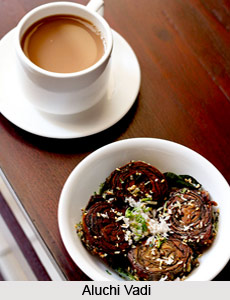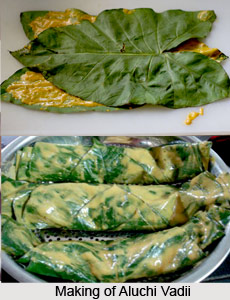 Aluchi Vadi also known as "Paatra" is a popular dish in Maharashtra as well as in Gujarat. It is made from Colocasia leaves. Aluchi Vadi is one the favourite tea time snack. This is a very popular snack all over India though the methods of making this differ. In Marathi cooking this is served as a snack by itself or as part of a meal.
Aluchi Vadi also known as "Paatra" is a popular dish in Maharashtra as well as in Gujarat. It is made from Colocasia leaves. Aluchi Vadi is one the favourite tea time snack. This is a very popular snack all over India though the methods of making this differ. In Marathi cooking this is served as a snack by itself or as part of a meal.
In Marathi, colocasia leaves are known as `Alu` or `Aloo`. This recipe has no resemblance to anything potatoes as in Hindi `Alu` or `Aloo` is the term for potatoes. Since fresh colocasia leaves or taro leaves are easily available in the monsoons, one can make this snack for Ganesh Chaturthi festival. This vegetable is particularly available in the rainy season and forms an integral part of a staple religious diet.
Preparation of Aluchi Vadi
The Colocasia leaves are smeared with a sweet, spicy and tangy besan or gram flour paste and stacked upon each other. They are then rolled and steamed. The steamed rolls are then tempered or fried. These stuffed rolls are served plain or with `Green Chutney`. They make for a nice tea time snack as well.
Ingredients:
•Colocasia Leaves - 6
Ingredients for Coating:
•Chickpea Flour (Besan) - 1 cup
•Ginger-Garlic-Green Chilli Paste - 1 tsp
•Tamarind Pulp - 2 tbsp
•Grated Jaggery - 1 tbsp
•Cumin Powder - 1 tsp
•Coriander Powder - 1 tsp
•Garam Masala - 1 tsp
•Red Chilli Powder - 1 tsp
•Asafoetida - 1 pinch
•Turmeric Powder - 1 tsp
•Sodium Bi-Carbonate - 1 pinch
•Ajwain - 1 tsp (optional)
•Salt to taste
•Water as required
Ingredients for Frying:
•Vegetable oil for deep frying
Ingredients for Tempering:
•Sesame Seeds - 2 to 3 tsp
•Mustard Seeds - 1 tsp
•Asafoetida Powder - 1/4 tsp
•Curry Leaves - 1 spring
•Grated Fresh Coconut - 1/4 cup
•Coriander Leaves - 2 tbsp, finely chopped
Method:
1. Wash the colocasia leaves and chop off the stems.
2. Soak the tamarind in 1/4 cup water for 30 mins.
3. Rinse the leaves well and wipe them dry.
4. Mix chickpea flour, ginger-garlic-green chilli paste, tamarind pulp, jaggery, cumin powder, coriander powder, garam masala, red chilli powder, asafoetida, turmeric powder, sodium bi-carbonate, ajwain and salt.
5. Add water bit by bit to make the coating `spreadable`.
6. Take a leaf, keep it upside down. Generously apply the coating on to it.
7. Keep another leaf over it covering it half way. Again apply the coating over it.
8. Once both leaves are fully coated, start rolling from one end towards the other. Repeat the process for other two pair of leaves.
9. At this step, one will have 3 rolls. Steam them in a pressure pan for 15 minutes. Remove from the pan and let it cool down.
 10. Cut the rolls into equal sized pieces and deep fry them oil.
10. Cut the rolls into equal sized pieces and deep fry them oil.
11. Heat oil in another pan and add mustard seeds.
12. Then add the sesame seeds, curry leaves and asafoetida. Saute for a few seconds.
13. Add the sliced rolls and saute till they get browned.
14. Garnish with grated coconut and fresh coriander. Serve hot with tea.
Notes
•Always use fresh leaves which are not itchy. The stems produce some juice which may cause throat irritation in some cases. To counter this effect, cut off the steams and coat the leaves with half of tamarind pulp and keep aside for 10 minutes.
•Do not use more than 3 leaves to make a roll. It will become too big and difficult to handle.
•Roll should be nice and tight. It will keep the Paatra round and whole after slicing and frying.
•One can make these rolls a day before and then temper or fry them the next day.
•The same recipe can also be made with large spinach leaves.




















